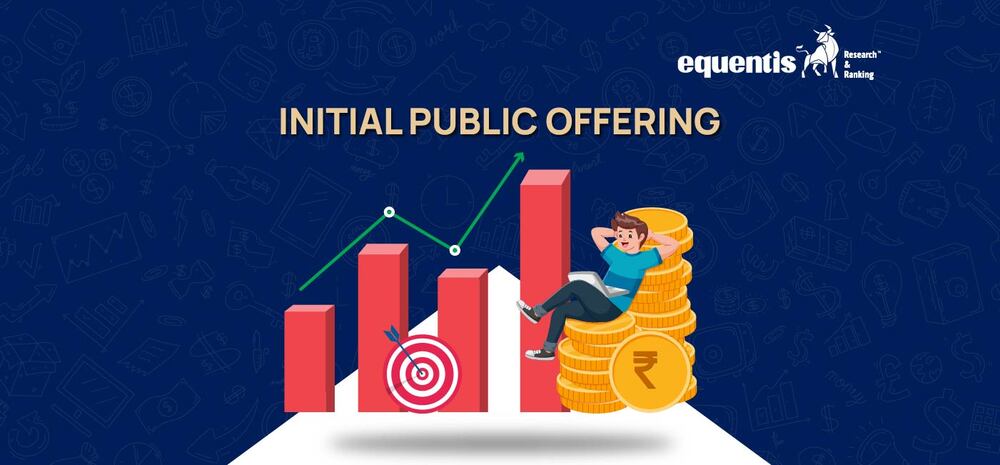Wondering what is the full form of IPO? Initial Public Offerings (IPOs) are key for companies looking to get more money to grow and expand. Keeping an eye on upcoming IPOs can give you a heads-up on some valuable opportunities to invest.
But making the most of these opportunities means you need to watch the market closely. To ensure that you make informed decisions that capitalize on the current market trends, monitoring both upcoming as well as current IPOs is crucial.
Monitoring and understanding IPOs can seem challenging at first. So, let’s break down what an Initial Public Offering (IPO) is, IPO full form in the share market, and why it matters.
What is IPO and the IPO Full Form?
An IPO share market full form is an Initial Public Offering. It is when a private company sells shares to the public for the first time.
The main reason a company announces an IPO is to raise money that helps it grow, expand, and carry out big plans. IPOs also make it easier for the company to trade its shares and raise money for future projects.
If you’re an investor, whether you’re part of a big institution, a high net-worth individual, or just someone interested in the stock market, an IPO gives you a chance to buy shares at the very beginning.
For example, when a company announces an IPO, they release a formal document called a prospectus. This document acts as a doorway to IPO and tells you everything about the company’s share offer, helping you make an informed investment decision.
After the IPO, the company’s shares get listed on a stock exchange and are available for everyone to buy and sell in the secondary market.
Now that we have looked at the IPO full form in the share market, let us see some types of IPOs, their eligibility requirements and benefits.
Types of IPO
After understanding the meaning and long form of IPO, here are the two types of IPOs:
- Fixed Price Offering
- Book Building Offering
| Category | Fixed Price Offering | Book Building Offering |
| Price Determination | The company predetermines the issue prices. | The company offers a price band within which you are allowed to bid. |
| Investor Bidding | You know the share prices upfront. | You bid on the shares, specifying the quantity and price. |
| Complexity | Simpler process with fewer steps | Has multiple steps and requires coordination across various stakeholders |
| Demand Visibility | Demand for the stocks is known only after the issue is closed. | The final price is determined based on your bidding activity. |
Eligibility and Requirements for IPO
Along with the IPO share market full form, it is also essential to know about the eligibility criteria for investors. The guidelines include-.
- You must be an adult and capable of entering into a legal contract.
- A PAN card issued by the Income Tax Department is mandatory.
- You must possess a valid demat account to hold securities electronically.
How to Apply for an IPO?
Step 1: Open a Demat or Trading Account
To apply for an IPO, you will first need to open a demat or trading account with a SEBI-certified Depository Participant. The documents you will need for this include your PAN, Aadhar and KYC identity and address proofs.
Step 2: Log in, Select and Apply for Your Desired IPO
Once this is done, you can apply for an IPO via –
- An ASBA (Application Supported by Blocked Account) facility – a facility introduced by the SEBI available with most banks via net banking on the bank’s website
- Your UPI ID
In both cases (UPI and ASBA), you will need to,
- Log into your account
- Navigate to the IPO section (E.g., it can be under a request section for bank portals)
- Select the IPO you want to invest in and fill out an application form.
- You may need to produce your KYC, DOB and PAN details again, along with providing information like the number of shares you want to bid and your bid price.
- Next, you will be asked to confirm the amount to be blocked from your account, agree to the terms and conditions and submit youR IPO applIcation.
Investment Benefits of IPO
Enhanced Visibility and Credibility
Investing in an IPO can help elevate a company’s visibility and credibility in the marketplace.
Becoming a publicly traded entity helps the company gain recognition and trust among investors, customers, and shareholders alike.
Access to Capital
One of the primary benefits of investing in an Initial Public Offering is the opportunity for a company to raise capital.
Going public allows the company to access a broader pool of investors and raises funds for various corporate purposes.
Diversification of Investment Portfolio
Investing in an IPO provides you with an opportunity to diversify your investment portfolios.
Purchasing shares of newly listed companies can help spread risks across different assets and sectors on the market. This reduces the possible adverse impact of any single investment on your overall portfolio.
Enhanced Management Discipline
Making the company public imposes a greater sense of accountability and transparency on the company management.
Publicly traded companies are subject to regulatory requirements and reporting standards. This encourages the company management to focus more on profitability, shareholder value, and long-term sustainability.
Independent Evaluation
As a company is made public, it undergoes scrutiny from external stakeholders, including analysts, institutional investors, and regulatory authorities.
These independent evaluations provide the company with valuable insights into factors like operations, performance, and even growth prospects.
This not only benefits the company by making room for improvement but also helps investors like you make informed decisions regarding any potential investments.
Conclusion
An IPO plays a crucial role in providing access to capital for companies. Offering shares to the public enhances the visibility and investor base of the companies.
Investing in an Initial Public Offering provides you with the benefits of portfolio diversification as well as enhanced management discipline and, independent evaluation.
However, the intricacies of the investment market can take time to navigate. With a reliable stock market advisory, navigating your investing possibilities becomes easier. Their customized portfolio management under a team that is backed up with extensive market research is the ideal fit, even if you are a new or experienced investor.
Know more about
IPOs | Current IPOs | Upcoming IPOs| Listed IPO
Frequently Asked Questions of IPO in the Stock Market
What is the IPO full form in the share market?
The full form of IPO in the stock market is Initial Public Offering.
Are there lock-in periods after purchasing shares in an Initial Public Offering?
Yes, there is a lock-in period for shares purchased in an Initial Public Offering. These lock-in periods vary depending on the type of investment made.
How are share prices in an IPO affected by the investor’s demand?
If the demand for the shares in an Initial Public Offering is higher than the supply, the prices of the shares will naturally increase.
*Disclaimer Note: The securities quoted, if any, are for illustration only and are not recommendatory. This article is for education purposes only and shall not be considered as recommendation or investment advice by Research & Ranking. We will not be liable for any losses that may occur. Investment in securities market are subject to market risks. Read all the related documents carefully before investing. Registration granted by SEBI, membership of BASL, and certification from NISM in no way guarantee the performance of the intermediary or provide any assurance of returns to investors.
How useful was this post?
Click on a star to rate it!
Average rating 2.5 / 5. Vote count: 4
No votes so far! Be the first to rate this post.
I’m Archana R. Chettiar, an experienced content creator with
an affinity for writing on personal finance and other financial content. I
love to write on equity investing, retirement, managing money, and more.
























